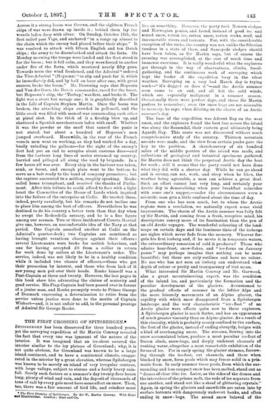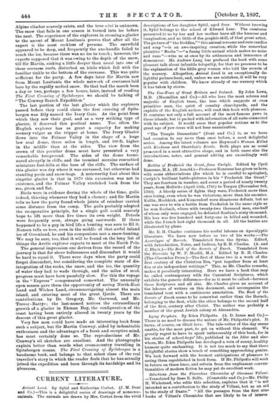THE FIRST CROSSING OF SPITSBERGEN.*
SPITSBERGEN has been discovered for three hundred years, yet the surveying expedition of Sir Martin Conway revealed the fact that every one was ignorant of the nature of the interior. It was imagined that an ice-sheet covered the interior similar to the icy plateau of Greenland ; why, it is not quite obvious, for Greenland was known to be a large island continent, and to have a continental climate, exagge- rated in the interior by a great elevation, whereas Spitsbergen was known to be merely an island of very irregular contour, with large valleys, subject to storms and a fairly heavy rain- fall. Surely such factors as a summer's day twenty-four hours long, plenty of wind and rain, and the deposit of thousands of tons of salt by every gale must have some effect on snow. Then, too, there was a fair amount of bird life, and reindeer must
• The First Crossing of Spitsbergen. By Sir W. Martin Conway. With Maps Sad Illintrations. London ; Dent and Co.
live on something. However, the party took Nausea sledges and Norwegian ponies, and found, instead of good ice, and sound snow, rotten ice, rotten snow, rotten rocks, mud, and innumerable rivers and torrents. For, with the considerable exception of the rocks, the country was not unlike the Siberian tundras in a state of thaw, and Samoyede sledges should have been taken, as Sir Martin says, but of course the crossing was accomplished, at the cost of much time and immense exertions. It is really wonderful what the explorers got through in the way of observations, climbs, fossil- gathering, and the continuous work of surveying which kept the leader of the expedition busy in the vilest weather. Surveying on a very bad March day is trying work—" it's dogged as does it "—and the Arctic summer soon came to an end, and all felt the cold winds, which are especially malignant in a summer season. Occasionally there were perfect days, and these Sir Martin prefers to remember; even the snow-bogs are not miserable to memory, he says, when dilating on the charm of an Arctic summer's day.
The base of the expedition was Advent Bay on the west coast, and the explorers found the best line across the island was along the Sassendal, their eastern goal ultimately being Agardh Bay. This route was not discovered without much comprehensive study of the country. Thirteen mountain ascents were made, and the view from certain peaks gave the key to the problem. A sketch-survey of six hundred miles of the middle portion of the island was made, and collections of geological and botanical specimens gathered. Sir Martin does not think the perpetual Arctic day the best for work ; still it seems that the party could not have done what they did with a shorter day. While he can go ahead and is strong, can eat, work, and sleep when he likes, the weather being agreeable, a man can achieve a great deal. Such an effort cannot last very long, and certainly your Arctic day is demoralising when your breakfast coincides with some one's supper,—under the circumstances even a scientific man gets a little confused about the time of day.
From one who has seen much, but to whom the Arctic regions were a revelation, we naturally expect some vivid impressions. The charm of the Arctic summer was fully felt by Sir Martin, and coming from a fresh, receptive mind, his descriptions convey more of its fascination than the pen of an old Arctic voyager. The wonderful colouring of the land-. acape on certain days and the luminous tints of the icebergs are eights which never fade from the memory. Whoever for- gets his first iceberg and, if he meets it in temperate waters, the extraordinary sensation of cold it produces? Those who admire hoar-frost, snow-flakes, and " ice-ferns on January panes " may perhaps imagine that nothing can be more beautiful; but those are only outlines and have no colour. No one who has not seen an iceberg can understand what depth of colour or purity and transparency of tint mean.
What interested Sir Martin Conway and Mr. Garwood, also a great mountaineering expert, was the condition of the inland ice, and particularly the formation and the peculiar development of the glaciers. Accustomed to the gradual effects of summer in the loftier Alps and the more leisurely movements of an Alpine glacier, the rapidity with which snow disappeared from a Spitsbergen landscape and the very characteristic " ice - foot " of an Arctic glacier were effects quite new to these explorers. A Spitsbergen glacier is much flatter, and has an appearanoe of much greater viscosity than an Alpine glacier. As a result of this viscosity, which is probably mostly confined to the surface, the foot of the glacier, instead of ending abruptly, bulges with a kind of overhanging snout. The streams, flowing into the snow accumulated below, produce a most peculiar ice-foot of frozen slush, snow-bogs, and deeply undercut channels of rushing water, altogether a most remarkable exhibition of the forms of ice. For in early spring the glacier streams, furrow- ing through the ice-foot, cut channels, and these when blocked by snow, form pools which may freeze solid in a pris- matic form. In early summer these pools, from which the sur- rounding and less compact snow has been melted, stand out as " domes of clear blue ice. Later, as the sides of the domes and the interstices of the prisms melt, the rods of ice separate from one another, and stand out like a sheaf of glittering crystals." Again, in spring the glaciers and anowfields are eaten into by surface torrents with dangerously undercut banks, and often ending in snow - bogs. The sound snow beloved of the Alpine climber scarcely exists, and the true neve is unknown. The snow that falls in one season is turned into ice before the next. The experience of the explorers in crossing a glacier to the ascent of Mount Lusitania proves that after all the expert is the most reckless of persons. The snowfield appeared to be deep, and frequently the axe-handle failed to touch the ice, because there was no ice to touch ; however, the experts supposed that it was owing to the depth of the snow, till Sir Martin, sinking a little deeper than usual into one of these crevasse roofs, disturbed an icicle which fell with the familiar tinkle to the bottom of the crevasse. This was quite sufficient for the party. A few days later Sir Martin saw from Mount Lusitania the whole network of crevasses laid bare by the rapidly melted snow. So that had the march been a day or two, perhaps a few hours, later, instead of reading The First Crossing of Spitsbergen we should be talking of ' The Conway Search Expedition."
The last portion of the last glacier which the explorers passed before they could claim the first crossing of Spits- bergen was fitly named the Ivory Gate. As the point from -which they saw their goal, and as a very striking type of glacier, it deserved this poetical name. Too often the English explorer has as great a capacity for making scenery vulgar as the tripper at home. The ivory Glacier flows into the Fulmar Talley in the shape of a huge low oval dome, three miles in length, and 400 ft. higher in the middle than at the sides. The view from the -crown of this peculiar dome must have presented a very remarkable foreground. The sides of the dome termi- nated abruptly in cliffs, and the terminal moraine resembled miniature foot-hills at the base of the cliffs. The surface of -this glacier was dry where it was crevassed, but otherwise had standing pools and snow-bogs. A noteworthy fact about this singular glacier is that in 1870 this extension was not in existence, and the Folmar Valley stretched back from the -sea, green and fiat.
Birds were in evidence during the whole of the time, gulls indeed, thieving whenever they had a chance; and Sir Martin tells us how the party found whole joints of reindeer carried some distance from the camp. The gulls probably adopted the co-operative principle, for a single gull could scarcely hope to lift more than five times its own weight. Petrels were frequently seen, always going eastwards. If there happened to be a gap in bird life a bunting was sure to fill it. Nansen tells us how, even in the middle of that awful inland ice of Greenland, he and his companions met a snow-bunting. We may be sure, too, that it will be found on the long list of things the Arctic explorer expects to meet at the North Pole.
The general impression one derives from the record of the journey is that for sheer tediousness and discomfort it would be hard to equal it. There were days when the party could forget discomfort, but considering the complete state of dis- integration of the rocks, the snow, and the ice, the quantity of water they had to wade through, and the miles of mud, progress must have been painfully slow. For this the voyage in the " Express " compensated somewhat. The unusually open season gave them the opportunity of seeing North-East Land and Wiches Land, circumnavigating almost the main island, and entering most of the great fjords. There are contributions by Dr. Gregory, Mr. Garwood, and Mr. Trevor-Battye ; the last-named notices the extraordinary growth of a glacier in Ekman Bay, the configuration of the coast having been entirely altered in twenty years by the descent of this great glacier.
Very few men could have made an interesting book from such a subject, but Sir Martin Conway, aided by indomitable enthusiasm and the advantages of a fresh and receptive mind, has most certainly done so. The reproductions of Mr.
Conway's oil sketches are excellent. And the photographs explain better than words what cross-country travelling in Spitsbergen means. The First Crossing of Spitsbergen is a handsome book, and belongs to that select class of the real traveller's story in which the reader feels that he has actually joined the expedition and been through its hardships and its pleasures.







































 Previous page
Previous page